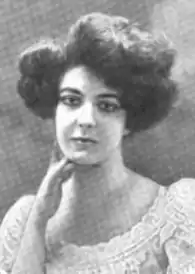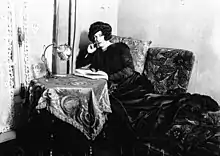

Agence_Rol_btv1b531938400_1.jpg.webp)
Jeanne Primitive Mette (16 March 1867 – 9 June 1955), better known under her married name, Jane Catulle-Mendès, and as a French poet[1] who also wrote plays[2] and other prose works, and contributed to Pierre Lafitte's Femina.
Life
Jane was born in Paris 16 March 1867, daughter of Célestin Marie Mette and Eugénie Mayer who had married in Neuilly-sur-Seine, Seine (now Hauts-de-Seine), November 18, 1869. She first married Louis Alexandre Boussac, a merchant, with whom 1889 she had a son Marcel. Marcel would become an industrialist tycoon whose holdings included the House of Dior and a highly successful racehorse stud, and who married the singer Fanny Held in 1939.
She and Boussac divorced on 27 June 1895, and she married Symbolist poet Catulle Mendès in Seine-et-Oise, July 8, 1897, who had separated from writer Judith Gautier in 1878 (divorced December 1896). His three daughters, who were portrayed in 1888 by Auguste Renoir,[3] were from his long relation with composer Augusta Holmès. Jane and him, yet to be married, had a son Jean Primice Catulle Mendès in the 16th arrondissement in Paris on July 10, 1896. In 1898, the couple were contributing subscribers to the completion and installation of Auguste Rodin's Monument to Balzac.[4]
The family lived at 6 quai de Seine in Chatou in 1897; in 1905 at 6 rue du Boccador, Paris; and in 1909 at 160 boulevard Malesherbes in Paris 17th, as well as renting, to spend summers there, a small terrace at 3, rue de Sully, Saint-Germain. On the way home from the latter where he was spending his winter writing, Catulle Mendès died on 8 February 1909, aged sixty-seven, crushed as he stepped, whether by mistake or on purpose is unknown, from the train in the tunnel of the Gare de l'Ouest near Saint-Germain-en-Laye and is buried in the Montparnasse Cemetery.[5][6]
Son Primice died in the lead-up to the second battle of the Marne, April 23, 1917.[7]
Writing
Recognised in 1904 with membership of the Le Prix “Vie heureuse” founded in that year, the publisher Hachette in its article on the Prize,[8] profiled her work Les Charmes, noting its three parts 'Waiting in the Garden,' a place haunted by poets Lord Byron, Musset, Virgil, her husband Catulle, Villon, Charles d'Orléans, Marguerite de Navarre, Rémy Belleau, Ronsard; Pascal, La Marquise, Aïsse, Baudelaire, Verlaine, Banville, Valmore, Vigny, Hugo ; 'The Promised Heart' (love poems); and the 'Alarmed Dream', which introduces new fears. In the first part, in the garden, she writes;
And I give them all my ardent childish
Tenderness... But sometimes, out of all I wildly imagine,
I discover their secret for having heard
In the voices of the garden, the soul of Lamartine
Et je leur donne à tous ma tendresse enfantine
Et grave… Mais parfois, de tout l’être éperdu,
J’ai surpris leur secret pour avoir entendu
Dans les voix du jardin l’âme de Lamartine
The article continues;
We are a little surprised not to find Mallarmé in this company. It seems that Mme Catulle Mendès owes him some beautiful verses. But the most beautiful, no doubt, ... although she has made some that are charmingly crafted, and that others are formed of a vapour finer than the shadow of a dream - the most beautiful are those stripped of all literature, those most simply of her soul. It is amazing that in this passionate poem there is not a cry. The accent is serious, ardent and mingled with a magnificent sadness: clairvoyance is the poetry of love, and one would find nothing more moving there than the sonnet in which she listens to a lover with intoxicated words:
Silently I listen to the poem…
Happy and sorrowful, oh my lover, I know:
You think of love, and it is I who love you.
In 1910 Jane's work was published, along with that of her husband Catulle Mendès, in the international magazine Poesia, founded in Milan in 1905 by Futurist Filippo Tommaso Marinetti.[9]
An unflattering portrayal of her in the Mercure de France in 1911 gave rise to a defamation lawsuit that writer André Rouveyre and the newspaper eventually lost.[10]
During World War 1 Jane was founder of a war charity in Paris and when in New York was invited in June 1915, to give a lecture in French in Pelham Manor, New York at the home of Frederick H. Allen and his wife Adele, whom she had met in Paris when Fred Allen was a lieutenant commander in the Naval Reserves Flying Corps and Adele was the head of the American Committee for Devastated France.[11]
After divorce from Boussac and her marriage to Catulle Mendès, distinguished member of the famous group of poets known as Le Parnasse, Jane had a son, Primice, who was killed on the battlefields of France in 1917 at the age of twenty.[12] Her La Prière sur l'enfant mort (Lemerre, 1921) was written in his memory and details her struggles, using her literary and other connections; Pierre Loti, a Russian general, and head of Russian ambulances, to obtain permission to go and recover his body for a proper burial.[13][14] On Armisitice Day, 11 November 1918, she wrote in La Prière: "Tears... tears..." adding, "The mere thought of those handsome soldiers, like him, who will be welcomed home in the light of day, makes me collapse..."[15]
In the 1920s she enjoyed a prosperous lifestyle and famous friends, some longstanding, like Sarah Bernhardt who had been the godmother of her son Primice.[16] Louise Faure-Favier, writing in 1927 on "Aviation and Literature" in La Mercure notes her holiday flight with Pierre Mille Yvonne Serruys from Antibes to Ajaccio.[17]
Jane established the Émile Verhaeren prize with money from her son Marcel from her first marriage.[18][19] She was a contributor to La Muse Française from 1922.[20]
Honours
Jane Catulle-Mendès was appointed knight and officer of the Legion of Honour and Knight of the Order Leopold I of Belgium.
Works
- Les Charmes, E. Fasquelle, Paris, 1904
- Le livre de Cynthia, sonnets (Mercure de France, 1912) Lire en ligne
- Le Cœur magnifique, A. Lemerre, Paris, 1909
- Les Petites confidences chez soi, E. Sansot, Paris, 1911
- Les Sept Filleuls de Janou, intermède héroïque en vers, avec Léon Guillot de Saix, Paris, Sarah-Bernhardt, 21 décembre 1915
- Poèmes des temps heureux, E. Flammarion, Paris, 1924
- France, ma bien aimée, E. Malfère, Amiens, 1925
- Ton amour n'est pas à toi, A. Michel, Paris, 1927
- L'Amant et l'Amour, roman, Baudinière, Paris, 1932
- Sampiero Corso : 1498–1567, Robeur, Paris, 1938
- Poésie et patrie. Le Chef et les siens, A. Michel, Paris, 1945
- La Bataille de Moscou, poème dramatique en un acte avec chœurs, Paris, Salle Pleyel, 25 février 1945
- La Ville merveilleuse, Rio de Janeiro, poèmes, E. Sansot, Paris, s. d.
- At the BNF
References
- ↑ Schultz, Gretchen (1999). The gendered lyric: subjectivity and difference in nineteenth-century French poetry. West Lafayette, Ind.: Purdue University Press. p. 85. ISBN 978-1-55753-135-3. OCLC 185606569.
- ↑ Beach, Cecelia (2005). Staging politics and gender: french women's drama 1880-1923. New York: Palgrave Macmillan. p. 40. ISBN 978-1-349-52917-9. OCLC 951524695.
- ↑ Renoir, Auguste (1888). "The Daughters of Catulle Mendès, Huguette (1871–1964), Claudine (1876–1937), and Helyonne (1879–1955)". The Met : European Paintings. Retrieved 2022-03-07.
- ↑ Morhardt, Mathias (15 December 1934). "La Bataille du "Balzac"". Mercure de France. pp. 463–489.
- ↑ Grison, Georges (9 February 1909). "L'accident mortel". Le Figaro.
- ↑ "Mendes Catulle". www.artlyriquefr.fr. Retrieved 2022-03-07.
- ↑ "Mendes Jane Catulle". www.artlyriquefr.fr. Retrieved 2022-03-07.
- ↑ Anonyme (1907), Le Prix "Vie heureuse", Hachette et Cie, pp. 1–58, retrieved 2022-03-07
- ↑ Valette (director), Alfred (16 March 1910). "Advertisement". Mercure de France.
- ↑ Brown, Kathryn, ed. (2020). Matisse's poets: critical performance in the artist's book. p. 236. ISBN 978-1-5013-2686-8. OCLC 1284933883.
- ↑ Semans, Barbara Broome; Schwarz, Letitia Broome (2009). John Broome and Rebecca Lloyd: their descendants and related families, 18th to 21st centuries. United States: Xlibris. p. 509. ISBN 978-1-4363-2384-0. OCLC 728099772.
- ↑ Simms, Norman (2018). Jews in an Illusion of Paradise: Dust and Ashes Volume Two--Falling out of Place and into History. p. 26. ISBN 978-1-5275-0743-2. OCLC 1022653058.
- ↑ Cooper, Clarissa Burnham (1943). Women poets of the twentieth century in France; a critical bibliography. New York: King's Crown Press. p. 97. OCLC 3308699.
- ↑ Jagielski, J.F.; Collective for International Research and Debate on the 1914-1918 War (November 2008). "Catulle-Mendes, Jane (1867-1955) – Témoignages de 1914-1918". Dictionary and Guide to Witnesses of The Great War 1914-18 (in French). Retrieved 2022-03-06.
{{cite web}}: CS1 maint: numeric names: authors list (link) - ↑ Cabanes, Bruno (2013-01-01). "Negotiating Intimacy in the Shadow of War (France, 1914-1920s): New Perspectives in the Cultural History of World War I". French Politics, Culture & Society. 31 (1): 1–23. doi:10.3167/fpcs.2013.310101. ISSN 1537-6370.
- ↑ Izard, Forrest (2010). Heroines of the modern stage. Place of publication not identified: Nabu Press. ISBN 978-1-177-21173-4. OCLC 944459245.
- ↑ Faure-Favier, Louise (15 October 1927). "Aviation et Littérature". Mercure de France. p. 337.
- ↑ "Chronique". Revue du Nord. 12 (47): 262–267. 1926.
- ↑ "Les courses et le prix Emile Verhaeren". Pourquoi Pas?. No. 803. 11 September 1931. p. 2113.
- ↑ "La Muse Française N°1 - 10 Mars 1922". revues61.rssing.com. Retrieved 2022-03-07.